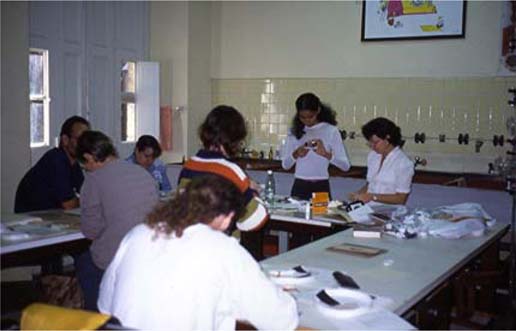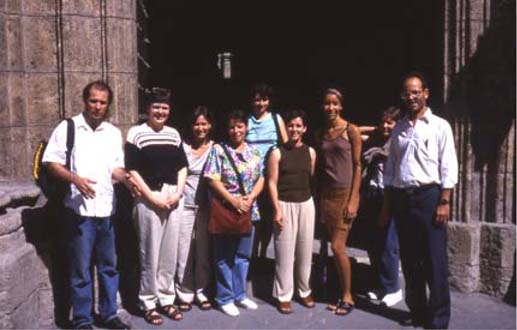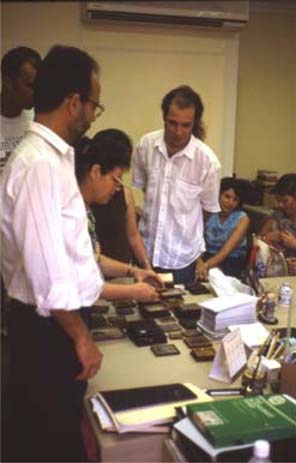
Topics in Photographic Preservation 2003, Volume 10, Article 6 (pp. 55-59)
Presented at the 2003 PMG Winter Meeting in San Juan, Puerto Rico.
Cuba, the “Pearl of the Antilles” is the largest and least commercialized Caribbean country. Its picturesque Spanish colonial towns, intriguing Afro-Cuban culture, rousing revolutionary monuments, catchy popular music, unblemished beaches, and enchanting countryside greet the traveler. The Cuban people are sincerely warm and friendly, and United States citizens receive the same spontaneous welcome that Cubans extend to all their guests.
For nearly four centuries, Cuba was the main gateway to Spain's vast American empire. With 2.2 million inhabitants, Havana is the largest city in Cuba and the Caribbean. It was founded on its present site in 1519, and is one of the oldest cities in the Americas. La Habana Vieja (Old Havana) is a designated UNESCO World Heritage Site.
The richness of Cuba's culture is well reflected in its many museums, several dozen of which are in Havana. The capital is a world-class artistic center with numerous galleries, theaters and literary shrines gracing the quaint colonial streets and squares. The historic collections in Cuba not only have a wealth of information about Cuban history but also record the time of American-Cuban relations.
Northeast Document Conservation Center (NEDCC) staff members, Walter Newman, Senior Paper Conservator and Ann Russell, Director, first went to Cuba in 1996. Over the past seven years NEDCC has worked with a number of Cuban cultural institutions to promote professional exchange in the field of preservation (Newman 2000). It has organized numerous seminars, lectures, and workshops in Havana, as well as visits to NEDCC by Cuban paper and book conservators.
The workshops included information on American photograph conservation techniques and identification of photographic prints. In final assessments, many participants classified this training in photograph conservation as a highlight of their experience in Andover and expressed a need to bring in-depth training to Cuban conservators.
As a result, Monique Fischer, Photograph Conservator at NEDCC traveled to Cuba in March 2001 to present a weeklong seminar on the conservation of photographs. The Getty Grant Program provided the funds and the workshop was held at the Cuban History Institute in Havana, an important associate and coordinator of the program. Fourteen mid-career conservators participated from institutions with notable photograph collections such as the National Archives and the State Council Archives.
The difficult task in preparing the lesson plan was deciding what to teach in a short period of time. What topics are important? How should they be covered? Should there be an emphasis on the problems associated with photograph collection in the tropics? What supplies would be needed? What demonstrations would be included?
After answering those questions, it was decided that the workshop agenda include a brief introduction to the history of photography, the identification of photographic prints, storage concerns, and basic treatment procedures such as surface cleaning, mending, and flattening. This exposure to basic photograph conservation opened the conservators' eyes to a new body of knowledge. They recognized that there was an urgent need for these specialized skills in Cuba.
A second workshop (see figure one), funded by the Samuel H. Kress Foundation, was built on the groundwork of the introductory program. In March of 2002, Monique Fischer traveled to Havana to present a five-day advanced level workshop on photograph conservation at the Cuban History Institute. This workshop was limited to six participants from the previous course since there were more hands-on demonstrations. The goals of the project were to increase the expertise of the Cuban conservators who could teach techniques for preserving photographs to others, and encourage an ongoing exchange of information between Cuban and American professionals.

Figure 1 Workshop at the Cuban History Institute
The participants included from left to right (see figure two below) Néstor Álvarez Garciga from CENCREM, Monique Fischer (instructor/author), Maritza Yanes from the Linguistic Institute, Maritza Dorta (coordinator of program at the Cuban History Institute), Gloria (archivist at The Museum of The City of Havana), Raisa Ruiz Arias from the State Council Archives, Jamina Thais from the National Archives, Marie Luz Gordon from the National Library and Luis Montes de Oca Colina Conservator at Cuban History Institute.

Figure 2 Participants
As with the first workshop there were geographic and time constraints. However, the problems were worked out differently. A Cuban History Institute staff member, Oman Batista, was able to translate three photograph conservation publications into Spanish; Debbie Hess Norris' The Conversation Treatment of Deteriorated Photographic Print Materials, James Reilly's Preserving Photograph Collections in Research Libraries, and Constance McCabe's JAIC article Preservation of 19th Century Negatives in the National Archives. These articles were chosen because they provided a good overview of photograph conservation dealing with both treatment and preservation issues. (The translated article can be viewed on the following website: http://nedcc.org/welcome/pubs.htm#pub4.)
The participants were asked to read the articles prior to the instructor's arrival. This reading assignment was very efficient. Not only did every person arrive at the workshop prepared but also many participants came with specific questions and concerns about their collections.
The advanced workshop included a review of different types of photographs followed by a presentation on written and photographic documentation and how to evaluate a photograph for treatment. Treatment procedures such as surface cleaning, backing removals, washing, mending and flattening were demonstrated. Both the pros and cons of each treatment were discussed. Other topics included plastics identification, care and identification of film-based photographic materials, disaster recovery and storage issues.
The class viewed the photograph collections at the Museum of the City of Havana, (see figure three) the State Council Archives (Fidel Castor's Library) and Cuban History Institute. The visits to the different institutions facilitated the discussion of problems facing photographic collections in Cuba. Many of the institutions have the same dilemmas: mold damage due to the tropical climate and lack of climate-controlled environments, lack of materials and equipment, need for proper archival storage enclosures and more staff training. After the workshop many of the participants were anxious to discuss the preservation needs of their respective photograph collections.

Figure 3 Museum of the City Havana
Even though many preservation problems still exist, many important changes had taken place between March 2001 and March 2002. Several new methods and materials had been implemented in various conservation labs. The conservator Raisa Ruiz Arias at the State Council Archives utilized A-D Strips on a collection of important negatives to illustrate to her administration the need for better storage. Luis Montes de Oca Colina, a recognized expert in photograph conservation in Cuba, trained and worked with a Columbian intern, Carolina Montero to produce a remarkable treatment portfolio.
In June 2003, a follow-up trip allowed two conservators; Néstor Álvarez Garciga and Raisa Ruiz Arias, to visit NEDCC for more instruction in photograph conservation. Many of the same techniques were reviewed but new material such as the preservation of color and contemporary photographs and digital techniques were introduced and discussed.
The workshops are a mutual exchange. A great benefit from these workshops is the continual contact the NEDCC staff has with their Cuban colleagues: asking technical questions, requesting bibliographies and publications. For the author, forming these professional relationships is the most rewarding.
The Cuban conservators were enthusiastic students, and excited to make use of their newly acquired techniques and information. Because of the constant lack of resources and materials, the Cuban conservators will need to decide how to best apply these techniques to their photograph collections. As colleagues, we can assist them in preserving their artistic and historic photographic works. There is not only an abundance of information about Cuban history but also a record of time of American-Cuban relations. The Cuban conservation community is eager for further educational programs and training in the specialized field of photograph conservation.
The author would like to thank The Getty Grant Program, the Samuel H. Kress Foundation, the Social Science Research Council, and Ann Russell for funding these programs. A special thanks to The Cuban History Institute, Marizta Dorta and Luis Montes de Oca Colina for coordinating the workshops and interpreter Oman Batista.
McCabe Constance. 1991. Preservation of 19th century negatives in the national archives. JAIC 30: 41–73.
Newman Walter and Todd Patterson. 2000. Cuban paradigms: the NEDCC experience. The Book and Paper Annual 19: 25–31.
Norris Debbie Hess. 1992. The conservation treatment of deteriorated photographic print materials. The Imperfect Image; Photographs their Past, Present and Future. London: The Centre for Photographic Conservation. 361–366.
Reilly, James M. 1991. Preserving photograph collections in research libraries: a perspective. In Photo Preservation and the Research Library. Mountview, CA. Research Libraries. 7–17.
Monique C. Fischer
Photograph Conservator
Northeast Document Conservation Center
100 Brickstone Square
Andover, MA 01810
E-mail: mfischer@nedcc.org
Luis Montes de Oca Colina
Conservator
Cuban History Institute Havan
E-mail: ihc@hist.cipcc.inf.cu
Papers Presented in Topics in Photographic Preservation, Volume 10 have not undergone a formal process of peer review.